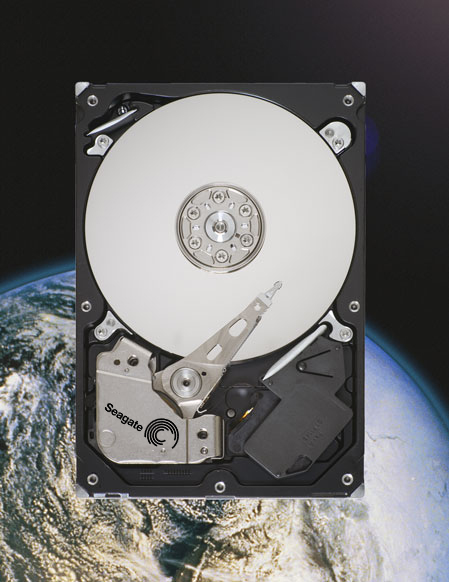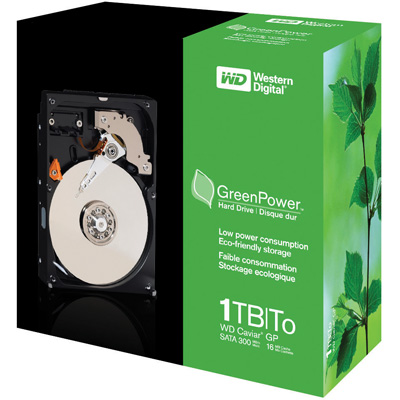Seagate and Western Digital 1TB Drives: Improved and Green
by Dave Robinet on November 26, 2007 7:00 AM EST- Posted in
- Storage
Introduction
When one manufacturer has a breakthrough in hard drive capacity, the other manufacturers rush to make sure their product line contains at least one entry at the new capacity level. However, it can sometimes take a while for actual product to arrive after these announcements, so it can be difficult to buy the particular drive that a consumer wants. Fortunately, the distribution channels have begun to fill with 1TB drives over the last several months, and consumers are now able to buy these massive hard drives with relative ease. In our head-to-head comparison today, we pit Seagate's 1TB Barracuda 7200.11 ES.2 against Western Digital's 1TB Caviar GP, along with updated results from the Hitachi 1TB drive that kicked off the "Era of Tera".
The Combatants
After Hitachi, Seagate was the first of our competitors out of the gate with its 1TB drive announcements, listing several different incarnations of its largest-capacity drive. Seagate positions their Barracuda 7200.11 as a desktop-class drive.

Seagate leverages its industry-leading five-year warranty and PMR recording technology in their mainstream 7200.11 desktop class drive. Anyone familiar with Seagate's drive naming conventions will recognize that this drive is the eleventh generation of their 7200RPM mainstream drives, marking over 15 years that they have been producing drives at that spindle speed. We were surprised once again at the launch of this new class of drive, as Seagate announced the 7200.10 series just over a year ago. The major enhancement in the 7200.11 product series over the 7200.10 is a simple increase in areal density. The platter size increases from 188GB on the 7200.10 series to 250GB on the 7200.11 product. This increase in density is the primary reason for the claim of this drive being "second generation PMR recording technology". The other major change is an increase from 16MB cache to 32MB cache on the 1TB drive. We will look to find out what performance benefits, if any, come with this "second generation" technology.

Western Digital followed Seagate's lead in introducing their 1TB Caviar GP in July of 2007, though their approach to the technology differs considerably. Where the Seagate drive focuses on reliability and trading on their established name, the Western Digital Caviar GP seeks to set itself apart with its low power consumption. This "green" approach - dubbed "environmentally responsible storage" in their product literature - attempts to portray the GP line as environmentally friendly due to a low power consumption figure. While we can all appreciate lower power requirements in our computing components, it remains an open question if users are willing to accept any performance trade-offs to get there. Our main question today is if Western Digital's focus on being "green" comes at the cost of performance, and how does the new Seagate 7200.11 compare to the 7200.10 series. Let us look at the specifications to see the numbers behind the headlines.










31 Comments
View All Comments
retrospooty - Monday, November 26, 2007 - link
I for one found the article helpful. It isn't about showing performance and choosing a winner based on speed, it is about showing all aspects of each and letting the buyer decide. Some people might want pure speed, and some might want a low power, quieter option.I think logic is lost on some people.
gmyx - Monday, November 26, 2007 - link
While 4w may not seem like much to a power user, it is a big deal to someone who is building a low power system such as a VIA based system. It's obviously not going to be used for playing games but can certainly work as a file server / internet proxy. When you can get a power supply with a total output of 60w (pico 60w power supply) every watt saved brings your total lower. A lower total mean less cost for your file server / internet proxy.Lonyo - Tuesday, November 27, 2007 - link
I would imagine it would also be nice for a low power home file server.1 of these 1TB drives would use probably <1/3rd of the power of 2x500GB drives, or ~1/2 the power of another 1TB drive.
If you have say a RAID-5 array with 5 or 6 of these drives, you're looking at a decent reduction in power which is always nice for a 24/7 machine.
Googer - Monday, November 26, 2007 - link
Those who have wanted to use low power hard drives on a desktop motherboard have always had the option of using 2.5" laptop drives.Dave Robinet - Monday, November 26, 2007 - link
Well put, Jarred.The Hitachi was reviewed some time ago, now, and (as you mention) its results are included in the charts. It gets mention in the conclusion as being the preferred option over the Seagate, as well.
The Green drive does have a place as a quiet drive (the quietest of the 1TB drives tested), and it comes at a low price point. That's considerable - particularly for HTPC users, who may not appreciate the Hitachi's noise.
For performance-oriented applications, though, it's a tough sell.
DigitalFreak - Monday, November 26, 2007 - link
Me thinks that this whole "green" thing from WD is because they were having issues producing a performance drive. Maybe the lower power consumption would make sense in a laptop drive, but I'd much rather have performance on the desktop.Seagate's ATA drives have always been so-so performers, so I'm not surprised with the outcome. However, they 5 year warranty more than makes up for it in a home server environment.
jojo4u - Monday, November 26, 2007 - link
Other drives are performing well. It's nice to have the choice. And there are uses for low-power high-capacity drives.jojo4u - Monday, November 26, 2007 - link
See page 2 and page 3 http://www.storagereview.com/1000.sr?page=0%2C2">http://www.storagereview.com/1000.sr?page=0%2C2Your low-level results also back this up.
DigitalFreak - Monday, November 26, 2007 - link
There was a discussion on their forums about how it would be prohibitively expensive to produce a drive that could vary it's spindle speed due to the extra stress on the mechanism.Interlink - Tuesday, November 27, 2007 - link
Anybody with a mic e.g. in his headset and a PC with microphon input is able to measure the fixed spindle speed of a WD10EACS: [url=http://forums.storagereview.net/index.php?showtopi...">http://forums.storagereview.net/index.p...c=26021&...]5400 rpm[/url].